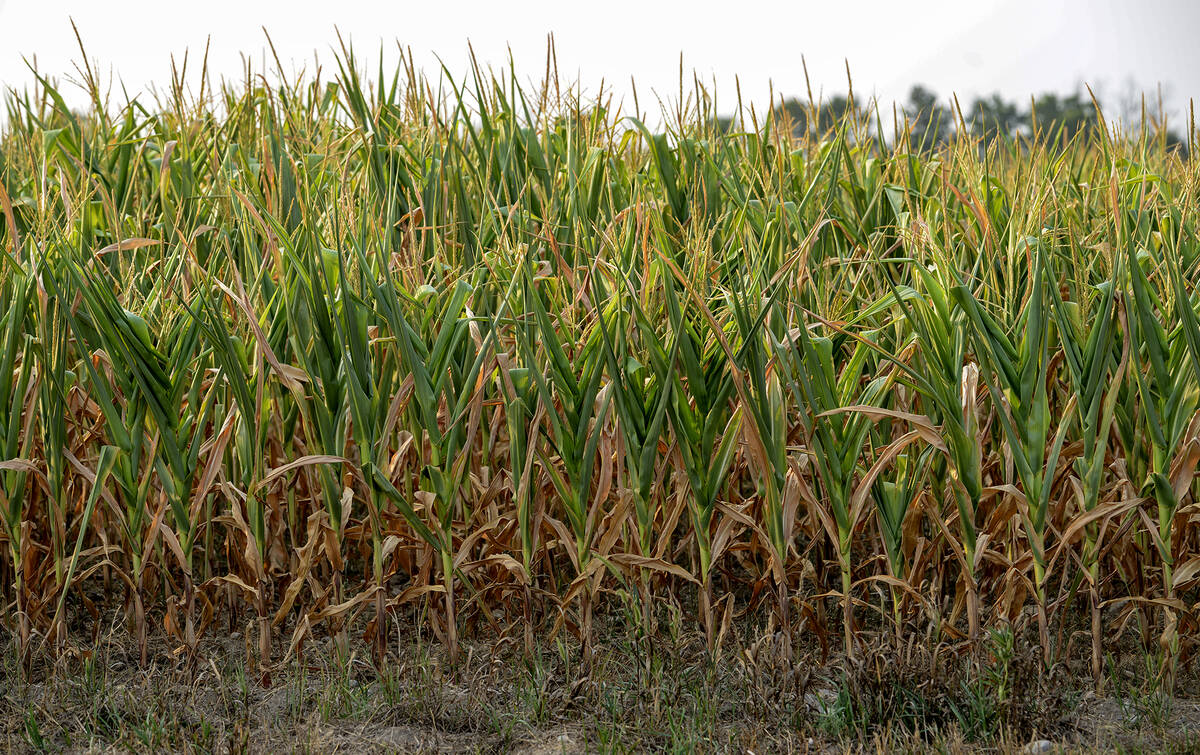Statistics Canada released its November crop survey Dec. 3, showing Ontario corn production at 9.5 million tonnes. This was down from the September estimate of 9.6 million tonnes but up from the 2020 crop of 8.9 million tonnes.
Ontario farmers harvested 4.1 million tonnes of soybeans. Although this was down from the September estimate of 4.4 million tonnes, the 2021 production was higher than the 2020 crop size of 3.9 million tonnes. Ontario winter wheat yields were historically high resulting in a production number of 2.7 million tonnes, up from the 2020 crop size of 2.3 million tonnes.
Quick look
Soybeans: A softening crude oil market has been a major factor driving the crush margin structure.
Corn: Seasonally strong export and domestic demand has reached its height.
Wheat: A surge in COVID-19 cases may spur on buyers to take additional coverage. It’s advised to be 50 per cent sold on 2021 production.
Read Also

Extreme variability marks Ontario’s 2025 corn crop
The yield potential of Ontario’s 2025 corn crop was lost in some areas due to extreme dry conditions.
The world corn market is focused on demand for U.S. supplies and South American production. U.S. corn exports are lagging year-ago levels but ethanol usage is up sharply.
U.S. soybean export sales are down 25 per cent from last year but the domestic crush pace is running slightly ahead of year-ago. Argentinean farmers had planted approximately 45 per cent of the corn crop and nearly 70 per cent of the soybeans as of Dec. 18.
Brazilian farmers have wrapped up soybean planting and the first corn crop. Rio Grande do Sul is on the dryer side and may temper first crop corn yields. However, it’s still early. The soybean harvest in Brazil will occur seven to 10 days earlier than normal. North American soybean prices will come under pressure in February as the Brazilian harvest moves into high gear.
U.S. wheat sales are down 23 per cent from last year largely due to lower production. The wheat market tends to experience a seasonal lull until February. It will focus on Northern Hemisphere winter wheat conditions in spring. Russia has lowered the wheat export quota beginning Feb. 15. Argentina has capped wheat and corn export sales to tame food inflation.
The Canadian dollar continues to depreciate against the U.S. greenback. Weaker crude oil prices and softer commodity markets are setting a negative tone for the resource-based currency. The U.S Federal Reserve will accelerate the tapering of bond purchases and three interest rate hikes appear to be in the cards for 2022.
This hawkish tone from the U.S. Central Bank is causing the U.S. dollar to surge against all other major currencies. U.S. inflation came in at 6.7 per cent for November, while the Canadian consumer price index was up 4.7 per cent from year-ago levels. Real wages are down two per cent in both Canada and the U.S., which may slow economic growth in the first half of 2022. Ocean freight rates have been grinding lower.
Soybeans
Ontario soybean production came in at 4.1 million tonnes on Statistics Canada’s November crop survey. This was up from the 2020 output of 3.9 million tonnes and up from the five-year average production of 3.8 million tonnes.
Farmers have been active sellers throughout the fall. Commercial stocks in the Ontario commercial system as of Dec. 12 were 125,700 tonnes. Exporters and domestic crushers appear to have their nearby requirements covered. Basis levels are expected to soften in January.
Ontario soybeans out of the St. Lawrence and U.S. soybeans from the Gulf are competitively priced on the world market. However, for February through June, Brazilian soybeans are a sharp discount to Ontario and U.S. origin.
The December USDA World Agriculture Supply and Demand Estimates (WASDE) confirmed a neutral to slightly bearish outlook for the soybean market. The U.S. domestic soybean crush is running slightly ahead of year-ago levels while exports are down 25 per cent from last year.
Without going into detail, the U.S. soybean carryout is expected to come in at 9.25 million tonnes. If we exclude the ending stocks from the 2018 and 2019 crop years due to adverse trade relations between the U.S. and China, the U.S. five-year average soybean carryout is 7.5 million tonnes. The North American soybean market will function to encourage demand in the latter half of the crop year.
Brazilian soybean production is expected to finish near 144 million tonnes, up from last year’s output of 138 million tonnes. Argentine soybean output is forecast to reach 49 million tonnes, marginally higher than the previous year’s 46 million tonnes.
It’s important to realize the oil component has been a major factor driving the crush margin structure. The crude oil market has been softening. More importantly, palm oil production is expected to recover in April. Argentina is the world’s largest soymeal exporter and aggressive competition on the world market will weigh on North American meal values later in March.
What to do: The soybean market will digest bearish fundamentals. In the previous issue, we advised producers to be 50 to 60 per cent sold. In this issue, we’re advising Ontario farmers to move up to 70 per cent sold on the 2021 production. Ontario prices are at six-month highs. We still have 30 per cent on hand in case of adverse weather in South America or dryer conditions in the U.S. this spring.
Corn
According to Statistics Canada, Ontario farmers harvested 9.5 million tonnes of corn, up from the 2020 crop of 8.9 million tonnes and up from the five-year average of 8.7 million tonnes. Ontario corn has been competitively priced with U.S. and European corn. Therefore, we’ve seen a year-over-year increase in offshore movement. Canadian crop-year-to date corn exports for the week ending Dec. 12 were 354,500 tonnes, up from the year-ago pace of 263,800 tonnes. Cattle on feed inventories are at seasonal highs enhancing domestic demand. Ontario ethanol production has been running ahead of year-ago levels due to the stronger energy complex. Bids from ethanol processors are sharp premium to local elevator prices in an effort to attract farmer selling.
U.S. corn demand is also moving through a seasonal high. The year-over-year increase in ethanol usage is offsetting the lag in exports. Last year, China stepped forward for larger volumes of U.S. corn during January. Recently, China has been buying Ukraine corn but we expect Chinese buyers to step forward for U.S. origin for their February through May import requirements. The USDA is forecasting the U.S. corn carryout to finish near 38 million tonnes. Analysts are expecting the USDA to bump up ethanol usage on upcoming WASDE reports. We wouldn’t be surprised to see the U.S. carryout finish around 35 million tonnes, down from the five-year average of 52.4 million tonnes.
The large exportable surplus from Brazil comes from the second corn crop, which will only be planted in February and harvested in June. Total Brazilian production is expected to reach 118 million tonnes, up from 87 million tonnes last year. The Argentinean corn harvest will occur in March, which will weigh on the world corn market. The U.S. market will ration demand later in spring. Export offers out of the Gulf will be premium to Argentinean and Brazilian origin. This will result in lower U.S. prices and spillover into the Ontario market as well.
What to do: In the previous issue, we advised Ontario farmers to be 40 per cent sold on their 2021 production. This week, we’re advising farmers to step up sales to 60 per cent. We’re at the height of seasonally strong export and domestic demand. Ontario corn production was sharply above the five-year average, which will also weigh on the basis in the latter half of the crop year.
Wheat
Statistics Canada’s crop survey had Ontario winter wheat production at 2.7 million tonnes, up from the 2020 crop of 2.3 million tonnes and up from the five-year average of two million tonnes. Approximately 30 per cent of the winter wheat crop was feed quality so milling wheat supplies are estimated at 1.9 million tonnes. Given the larger crop size, Ontario milling supplies are slightly larger than earlier anticipated. Ontario spring wheat production came in at 142,500 tonnes, down only 4,000 tonnes from the 2020 crop.
At the time of writing in mid-December, elevator bids for soft red winter wheat were hovering at $8.80-$8.90 per bushel. This is down approximately 50 cents per bu. from the November average. The market tends to experience a seasonal lull in December and January. Major buyers have covered their requirements. The lakes are closed and exports slow down through the St Lawrence River. Wheat merchants take holidays and there are few major tenders.
Looking back at the 2007/08 crop year, the wheat complex experienced a major rally in February and March of 2008. We’re looking at a repeat of this price behavior because stocks in the major exporting countries will drop to similar levels. The wheat complex tends to incorporate a risk premium when the Northern Hemisphere crop comes out of dormancy. This risk premium becomes enhanced if one of the major regions experiences adverse conditions.
We’ve advised producers to wait for this next seasonal rally. Given the tighter stocks, the world cannot afford a crop problem in one of the major exporters. Oklahoma and Texas continue to experience drought-like conditions. Russia and Ukraine have received adequate precipitation so far.
The longer-term forecast appears to be somewhat dryer for the main winter wheat region in Ukraine. Eastern Europe went into dormancy rather dry and timely precipitation will be needed in spring. France and Germany are in good shape so far. The bulk of Western Canada and North Dakota are still recovering from this last season’s drought.
What to do: The wheat complex tends to strengthen when there is a surge in COVID-19 cases. This Omicron variant of the coronavirus may spur buyers to take additional coverage. We’ve advised Ontario farmers to be 50 per cent sold on their 2021 wheat production. That’s enough for now. Plan to make the next sale in February.













